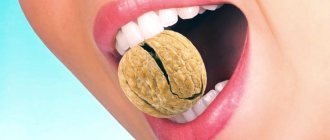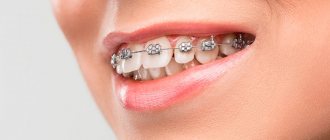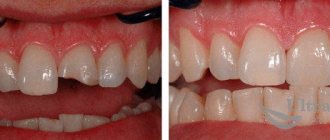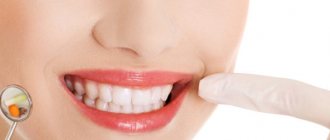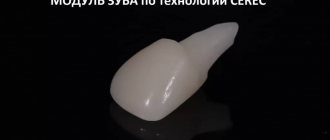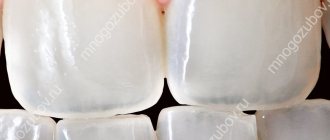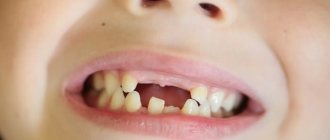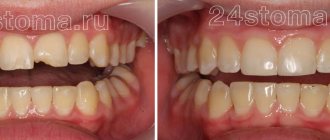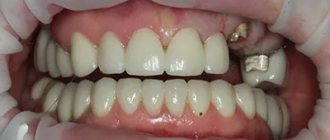What can you do at home?
Help in the clinic Chip or crack in the enamel Part of the tooth has broken off The filling has broken off The crown has broken The root has broken Fracture after prosthetics The tooth has broken off. This happens as a result of a blow from a fall, an accident, or practicing a variety. But the list of reasons why part of a tooth broke off is not limited to this. The list includes:
- Bad habits
Those who like to chew seeds, nuts, crackers and their nails have a higher risk of damage.
- Incorrect installation of the pin inside the canal
The tooth is restored with a pin only if no more than 40%
coronal part. In case of severe damage, inlays are used. But the dentist does not always want to tinker with the manufacture of microprostheses. He inserts the pin, securing it with filling material. This design does not withstand the chewing load well and does not last long. The wall of the tooth breaks off.
- Trauma caused by malocclusion
Occlusion
- this is the position (contact) of the teeth when closing. Malocclusion, congenital or formed by faulty prosthetics) leads to the fact that the load on individual teeth is too great. They can’t stand it and the tooth chips.
- Complications of non-carious diseases
Fluorosis, hypoplasia, tumors and cysts lead to demineralization of hard tissues. It is not uncommon for a piece of a tooth to break off due to these diseases.
- Orthodontic treatment
Braces can also cause demineralization, even if they are installed correctly. This often ends in chips and cracks. Improperly installed structures cause traumatic damage to teeth, including fractures.
What to do if a tooth is broken
It is clear that if a tooth is broken at the root, the patient will immediately consult a doctor, but one should not think that small chips and cracks can wait. The sharp edge scratches the tongue and cheek from the inside and can cause traumatic stomatitis. Cracks in the enamel deepen and lead to tooth hypersensitivity. A chip of any tooth affects the distribution of the chewing load. For intact teeth, it increases significantly, and this threatens additional injuries, now to these units.
Violation of the integrity of the tooth opens the way to internal tissues for pathogenic bacteria. Minor trauma can result in caries, pulpitis (inflammation of the pulp), periodontitis (inflammation of the tissue around the root), and ultimately, tooth loss. Therefore, a visit to the dentist is the first thing you need to do.
Possible complications
Complex injuries can often have serious consequences, manifested in complications. It doesn’t matter which tooth was injured – the front incisor, the chewing tooth. After the examination, the doctor will decide how to save the child’s tooth. If you neglect the recommendations of a specialist, this can lead to more serious consequences, not to mention aesthetics.
Types of complications
1. Possibility of infection of the pulp area.
2. Increased tooth sensitivity.
3. The appearance of a bend in the tooth root.
4. Violation of occlusion.
5. Formation of cysts and granulomas.
You need to prepare for the fact that a damaged child’s tooth will begin to change the angle of development. And this leads to deformation not only of the damaged tooth, but also of its healthy neighbors. If it is necessary to remove a broken tooth, the space must be filled with an implant. If filling is not carried out, other teeth will begin to shift and move closer together, which leads to occlusion disorders - bite.
What kind of help will be provided at the clinic?
First of all, the dentist will conduct a diagnosis. The dentist will examine your mouth and take an x-ray. It will show:
- how deep is the crack?
- whether the root is affected;
- whether soft tissues are injured or not;
- what state the channels are in.
Treatment is carried out depending on the defect.
Chips and cracks in enamel
The mildest degree of damage. Teeth react to irritants and ache when eating. The restoration is carried out with filling material; before this, the corners and sharp edges are polished. According to indications, veneers are installed on damaged enamel. They are made either from a composite, covering the surface layer by layer, or from ceramics. Ceramic veneers are made from individual impressions in a dental laboratory. They are more expensive, but last longer and retain their attractive appearance for years.
Some patients believe that it is not necessary to treat the back teeth; they are still not visible. But enamel damage is a gateway for pathogenic microorganisms. To prevent serious diseases, the enamel must be restored.
Loss of part of a tooth
If a front tooth breaks off, it will be built up with a composite material. These teeth look natural and can last for many years. When chips and cracks are very noticeable, the tooth is replaced with a veneer or it is ground down and a crown is put on. If part of a front tooth is broken, ceramic restorations will disguise the problem so that others will not realize that the crown is artificial. They imitate tooth enamel as accurately as possible.
If the wall of a chewing tooth has broken off, veneers will not help. Here you need prosthetics on a pin or stump tab (if half of the tooth or more has broken off). A pin (fiberglass pin) is inserted into the canal. It provides stability to the tooth, and a crown is placed on top for its protection and aesthetic purposes. Prosthetics with an inlay requires taking impressions. Inlays are made in a dental laboratory. The root end is inserted into the canal, and the prosthesis is put on the coronal part.
A tooth with a filling broke off
The doctor assesses the condition of the canal using an x-ray. If the canals are well sealed, then they immediately move on to prosthetics or extensions. If the canals are poorly isolated, an inflammatory process can begin there, so before extension, endodontic treatment is carried out - the canals are re-treated, the inflammation is eliminated, and only then the tooth is restored.
Broken tooth crown
When the enamel is fractured, patients complain that the sharp edge has injured their cheek or lip, but do not experience pain. The dentist grinds down the sharp edges and restores the tooth with composite.
A fracture of the crown (dentine) most often occurs due to injury, and it cannot be done without pain. The fracture can run along the tooth or break it in half.
Treatment depends on whether the pulp (nerve) is involved or not.
In case of a fracture without damage to the pulp, a pad with calcium hydroxide is placed in the pulp chamber and a temporary filling is placed. They observe how the pulp behaves, whether there is pain, and whether the neurovascular bundle has retained its viability. If events develop favorably, the temporary filling is replaced with a permanent one. The half tooth is built up with a composite; in case of large damage, a veneer or crown is used.
If a tooth breaks in the gum, this most often means that the pulp is exposed. In such cases, the treatment plan and its outcome are influenced by the time of treatment and the age of the patient. For unformed roots in children, direct pulpotherapy is performed with a calcium-containing pad. The sooner a patient sees a doctor (the first 24 hours
), the greater the likelihood of saving the pulp before necrosis begins. If the incisors are fractured or if a molar tooth is broken and hurts, it is important for children to see a doctor as quickly as possible. The pulp can be preserved, the tooth will remain alive, tissue exchange and normal blood supply will continue to occur in it. This is important for the formation of permanent roots.
In cases of late presentation, treatment begins with the removal of moving fragments and amputation of the pulp. The canals are then isolated with gutta-percha. Prosthetics are performed with an inlay and a crown.
When wisdom teeth are fractured, they are most often simply removed.
In adults, the exposed pulp is removed immediately, then the canals are filled and the coronal part is restored.
If the crown is completely fractured (the tooth is broken under the gum, but the root remains), it can be used with a pin. In cases where the natural crown has not been preserved, prosthetics are performed on the stump inlay.
The root broke
The most difficult of injuries. Restoring a chipped tooth is quite simple; putting the root fragments back together is much more difficult. First, the pulp is checked for viability. To do this, electrical and temperature tests are carried out. If the nerve responds to stimuli, the root fragments fit together like a puzzle. A splint is then applied to ensure immobility. The patient wears the splint for approximately 3 months
, with control checks
after 1 and 2 months
. After this, the debris is checked for mobility. If they move, the tire is reinstalled. In a stationary state, a mineralized connection is formed between the fragments and the root can perform its functions.
If the pulp is dead, the tooth is removed followed by prosthetics or implantation.
Fracture after prosthetics
The reason that a tooth under the crown has broken may be that:
- excessive loads were placed on the tooth;
- preparation before prosthetics was carried out poorly;
- treatment before installing the crown was incorrect;
- hard tissues are eaten away by caries, the tooth under restoration is rotten.
Treatment is carried out based on diagnosis. If the roots of the tooth are preserved, then the canals are re-treated, and then prosthetics are performed on the stump inlay (if the tooth is destroyed by half or more). In the case when the root is inflamed, the pathological process has gone far, tissue necrosis has begun, and the tooth is removed. Then implantation is performed or a bridge is installed.
With bridge prosthetics, it is not possible to stop the loss of bone tissue; adjacent teeth have to be ground down, before which the nerves (pulp) are removed from them. Such units do not receive minerals, become brittle, and quickly collapse. A pulpless tooth is considered dead.
The implant functions as a natural root, completely restores chewing function, and prevents bone tissue atrophy.
Causes
The root of a tooth or its crown can break for various reasons. The most common:
- genetically determined anomalies in the structure of hard dental tissues;
- metabolic disorders caused by problems with the absorption of calcium, phosphorus, fluorine;
- rickets;
- unbalanced diet;
- diseases of the gastrointestinal tract, due to which the level of acidity of saliva changes sharply.
Among the external factors leading to dental fractures, the following should be mentioned:
- blows to the head during a fight, sports, or traffic accidents;
- damage to the unit due to careless dental procedures;
- habit of gnawing hard foreign objects, crackers, candies;
- simultaneous consumption of very hot and cold foods or drinks;
- malocclusions, due to which increased pressure is placed on individual units;
- advanced caries, reducing the volume of healthy hard tissues.
conclusions
- Restoration is possible if the upper, lower, front or side teeth have broken off;
- For restoration, methods of mineralization, plugging with a composite, extension, prosthetics with a crown on a pin, or a stump inlay are used;
- if the root is preserved, the tooth can be restored, even if the coronal part is fractured at the base;
- a root fracture can be treated if the pulp is not damaged;
- in cases where the tooth cannot be saved, it is removed, followed by implantation or installation of a bridge;
- The implant performs all the functions of a natural tooth and prevents bone tissue atrophy;
- the extended tooth is no different from others and looks natural.
Expert of the article Bolshakova Evgenia Vladimirovna Dentist-hygienist
More than 11 years of experience
How to restore a damaged area?
A child with a chipped tooth should be taken to the dentist immediately. The doctor will fill the canals in the exposed pulp and remove the nerve bundle. In general, different methods and technologies are used today to restore and preserve teeth.
- For a broken tooth, dental crowns are used.
- The doctor can place veneers for children.
- When a tooth is broken or chipped, your doctor may place baby inlays.
The use of a crown is advisable when a tooth in the upper row of incisors is broken or when the chewing teeth are damaged. But at the same time, processing (grinding) is carried out on neighboring ones.
You can restore your front teeth thanks to thin onlays - veneers, which can be matched to the rest of your teeth. If a tooth is broken and cannot be restored, the doctor will clean the canals and install an inlay (implant).
With the help of intracanal pins, it is possible to restore a chipped tooth if the parents decided to save it. With this method of dentures, aesthetics are preserved as much as possible. The operation will not affect the bite or chewing function.
When you have to remove a broken tooth along with the root
Tearing out a broken unit is the most undesirable scenario for any patient, because artificial units, no matter how high-quality and beautiful they are, are still inferior to natural ones. Unfortunately, it is not always possible to save a damaged tooth. Removal is indicated when:
- root damage;
- putrefactive processes in the deep tissues of the gums and jawbone;
- root fracture.
Since the crown is broken, it is impossible to remove debris from the gums using the classical method. The doctor administers anesthesia. Then he cuts through the gum and gets access to the roots. Removes them one by one.
When the wound heals, discusses with the patient how to close the dental defect. In some cases, a decision is made to perform simultaneous implantation with immediate loading. Then, immediately after the operation, the patient goes home with a pin and a temporary crown implanted into the jawbone. The latter will soon be replaced with a permanent one.
Signs of a fracture
It is almost impossible not to notice that the crown is cracked. After all, at the moment of its damage, severe pain appears. The unit soon ceases to be sensitive, as its layers are deprived of adequate nutrition.
To see the location of the defect, you need to carefully examine your smile in the mirror. A crack will be noticeable on the surface, running along or across. It also happens that a large fragment breaks off immediately. Then a sharp break line is formed, which injures the mucous membranes of the inner surface of the lips and cheeks, and the tongue.
Diagnostic measures
If the tooth has broken off to the gum line, the dentist will conduct an examination. He is studying:
- whether the surrounding areas are damaged;
- are there necrotic areas?
- whether blood got into the dental cavity;
- what condition are the roots in?
To clarify the situation completely, the patient is asked to undergo an x-ray. From the image you can understand whether the roots have shifted, whether the nerve fibers are damaged, and what condition the remaining solid structures are in.
Composite restoration
Restoration of chipped front teeth is carried out using a composite material. The dentist selects a composite filling identical in color to the natural shade of the tooth and builds up (fills) the missing part, making the smile as aesthetically attractive as before. This type of defect elimination is the most common and highly effective. Also, the reasonable price makes it accessible to every person.
Restoring anterior teeth with composite materials is possible:
— for small defect areas;
— in case of mechanical damage;
- with focal destruction by caries.
This method of restoration is in many ways superior to traditional filling, as it guarantees not only functionality, but also allows the restoration of damaged tissue (enamel, dentin) and the aesthetics of the smile. Composite restoration guarantees the original color, transparency and shape. Thanks to this, the restored tooth becomes absolutely identical to the natural one.
Restoration with composites can be indirect or direct. The first is carried out in special dental clinics, where all the necessary composite blanks are prepared for the client. The second is the application of a composite material directly to the surface (filling).
The procedure has many advantages, one of the main ones being the short session time and durability.
